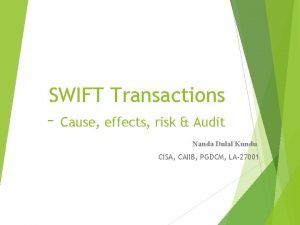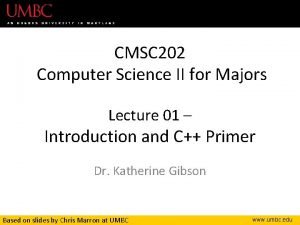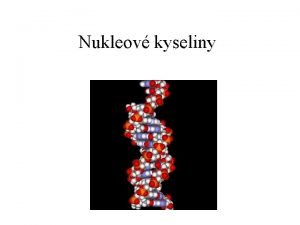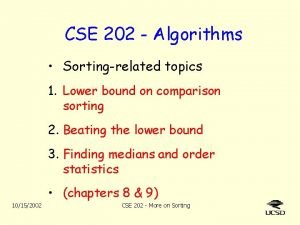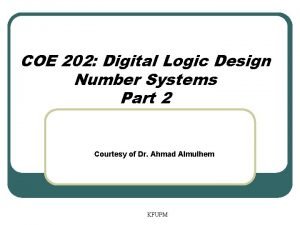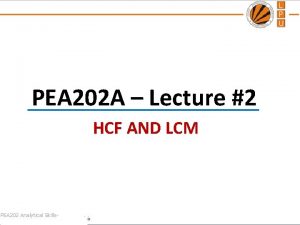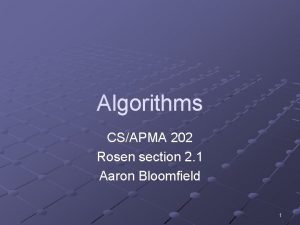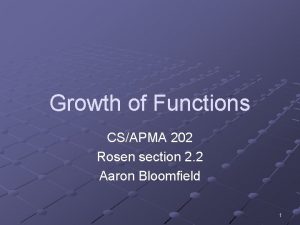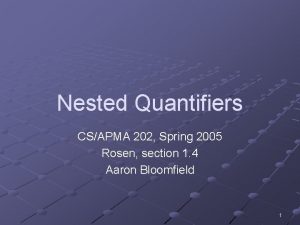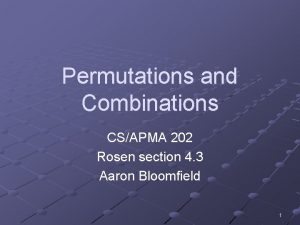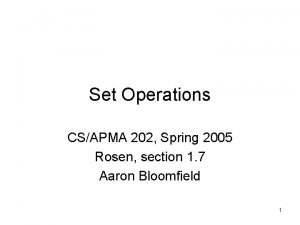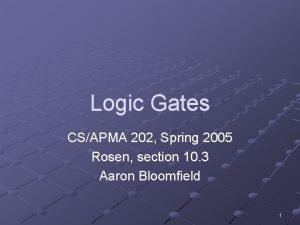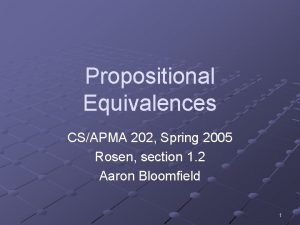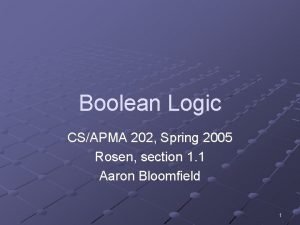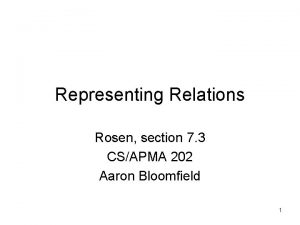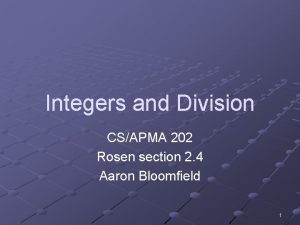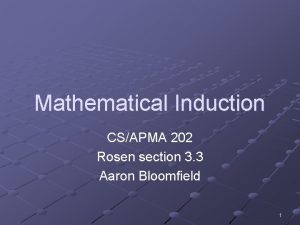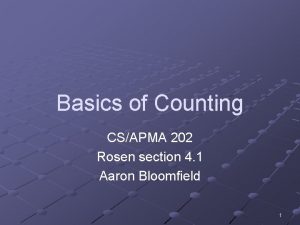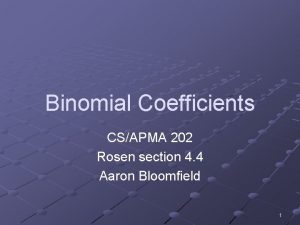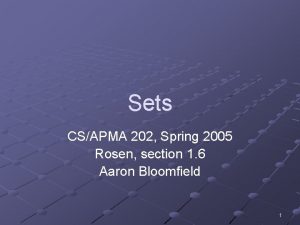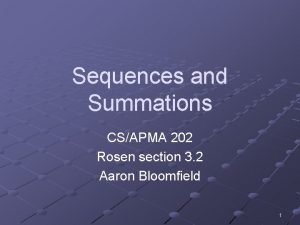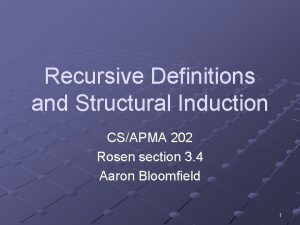Functions CSAPMA 202 Rosen section 1 8 Aaron

































- Slides: 33

Functions CS/APMA 202 Rosen section 1. 8 Aaron Bloomfield 1

Definition of a function A function takes an element from a set and maps it to a UNIQUE element in another set 2

Function terminology f maps R to Z Domain R f Z Co-domain f(4. 3) 4 4. 3 Pre-image of 4 Image of 4. 3 3

More functions A pre-image of 1 The image of A Domain Co-domain Alice A “a” 1 Bob B “bb“ 2 Chris C “cccc” 3 Dave D “dd” 4 Emma F “e” 5 A class grade function A string length function 4

Even more functions Range a 1 “a” 1 e 2 “bb“ 2 i 3 “cccc” 3 o 4 “dd” 4 u 5 “e” 5 Some function… Not a valid function! Also not a valid function! 5

Function arithmetic Let f 1(x) = 2 x Let f 2(x) = x 2 f 1+f 2 = (f 1+f 2)(x) = f 1(x)+f 2(x) = 2 x+x 2 f 1*f 2 = (f 1*f 2)(x) = f 1(x)*f 2(x) = 2 x*x 2 = 2 x 3 6

One-to-one functions A function is one-to-one if each element in the co-domain has a unique pre-image a 1 e 2 i 3 o 4 5 A one-to-one function 5 A function that is not one-to-one 7

More on one-to-one Injective is synonymous with one-to-one n “A function is injective” A function is an injection if it is one-to-one Note that there can be un-used elements in the co-domain a 1 e 2 i 3 o 4 5 A one-to-one function 8

Onto functions A function is onto if each element in the co -domain is an image of some pre-image a 1 e 2 i 3 o 4 u An onto function 5 A function that is not onto 9

More on onto Surjective is synonymous with onto n “A function is surjective” A function is an surjection if it is onto Note that there can be multiply used elements in the co-domain a 1 e 2 i 3 o 4 u An onto function 10

Onto vs. one-to-one Are the following functions onto, one-toone, both, or neither? a 1 b 2 c 3 4 d 4 1 -to-1, not onto Both 1 -to-1 and onto a 1 b 2 c 3 d 4 d Onto, not 1 -to-1 Neither 1 -to-1 nor onto a 1 b 2 c 3 4 Not a valid function 11

Bijections Consider a function that is both one-to-one and onto: a 1 b 2 c 3 d 4 Such a function is a one-to-one correspondence, or a bijection 13

Identity functions A function such that the image and the pre -image are ALWAYS equal f(x) = 1*x f(x) = x + 0 The domain and the co-domain must be the same set 14

Inverse functions Let f(x) = 2*x R f-1 f(4. 3) 8. 6 4. 3 f-1(8. 6) Then f-1(x) = x/2 15

More on inverse functions Can we define the inverse of the following functions? a 1 b 2 c 3 4 d What is f-1(2)? Not onto! What is f-1(2)? Not 1 -to-1! An inverse function can ONLY be done defined on a bijection 16

Compositions of functions Let (f ○ g)(x) = f(g(x)) Let f(x) = 2 x+3 Let g(x) = 3 x+2 g(1) = 5, f(5) = 13 Thus, (f ○ g)(1) = f(g(1)) = 13 17

Compositions of functions f○g A B C g f g(a) f(a) a g(a) f(g(a)) (f ○ g)(a) 18

Compositions of functions Let f(x) = 2 x+3 f○g R Let g(x) = 3 x+2 R R g f g(1) f(5) f(g(1))=13 1 g(1)=5 (f ○ g)(1) f(g(x)) = 2(3 x+2)+3 = 6 x+7 19

Compositions of functions Does f(g(x)) = g(f(x))? Let f(x) = 2 x+3 Let g(x) = 3 x+2 f(g(x)) = 2(3 x+2)+3 = 6 x+7 Not equal! g(f(x)) = 3(2 x+3)+2 = 6 x+11 Function composition is not commutative! 20

Graphs of functions f(x)=3 x=1 Let f(x)=2 x+1 Plot (x, f(x)) f(x)=5 x=2 This is a plot of f(x) 21

Useful functions Floor: x means take the greatest integer less than or equal to the number Ceiling: x means take the lowest integer greater than or equal to the number round(x) = floor(x+0. 5) 22

Rosen, question 8 (§ 1. 8) Find these values 1. 1 -0. 1 2. 99 -2. 99 ½+ ½ ½ + ½ 1 2 -1 0 3 -2 ½+1 = 3/2 = 1 0 + 1 + ½ = 3/2 = 2 23

Ceiling and floor properties Let n be an integer (1 a) x = n if and only if n ≤ x < n+1 (1 b) x = n if and only if n-1 < x ≤ n (1 c) x = n if and only if x-1 < n ≤ x (1 d) x = n if and only if x ≤ n < x+1 (2) x-1 < x ≤ = x < x+1 (3 a) -x = - x (3 b) -x = - x (4 a) x+n = x +n (4 b) x+n = x +n 24

Ceiling property proof Prove rule 4 a: x+n = x +n n n Where n is an integer Will use rule 1 a: x = n if and only if n ≤ x < n+1 Direct proof! n n n Let m = x Thus, m ≤ x < m+1 (by rule 1 a) Add n to both sides: m+n ≤ x+n < m+n+1 By rule 4 a, m+n = x+n Since m = x , m+n also equals x +n Thus, x +n = m+n = x+n 25

Factorial is denoted by n! n! = n * (n-1) * (n-2) * … * 2 * 1 Thus, 6! = 6 * 5 * 4 * 3 * 2 * 1 = 720 Note that 0! is defined to equal 1 26

Proving function problems Rosen, question 32, § 1. 8 Let f be a function from A to B, and let S and T be subsets of A. Show that 27

Proving function problems Rosen, question 32 (a): f(SUT) = f(S) U f(T) Will show that each side is a subset of the other Two cases! Show that f(SUT) f(S) U f(T) n n Let b f(SUT). Thus, b=f(a) for some a S U T Either a S, in which case b f(S) Or a T, in which case b f(T) Thus, b f(S) U f(T) Show that f(S) U f(T) f(S U T) n n Let b f(S) U f(T) Either b f(S) or b f(T) (or both!) Thus, b = f(a) for some a S or some a T In either case, b = f(a) for some a S U T 28

Proving function problems Rosen, question 32 (b): f(S∩T) f(S) ∩ f(T) Let b f(S∩T). Then b = f(a) for some a S∩T This implies that a S and a T Thus, b f(S) and b f(T) Therefore, b f(S) ∩ f(T) 29

Proving function problems Rosen, question 62, § 1. 8 Let f be an invertible function from Y to Z Let g be an invertible function from X to Y Show that the inverse of f○g is: n (f○g)-1 = g-1 ○ f-1 30

Proving function problems Rosen, question 62, § 1. 8 Thus, we want to show, for all z Z and x X The second equality is similar 31

Quick survey n a) b) c) d) I felt I understood the material in this slide set… Very well With some review, I’ll be good Not really Not at all 32

Quick survey n a) b) c) d) The pace of the lecture for this slide set was… Fast About right A little slow Too slow 33

Quick survey n a) b) c) d) How interesting was the material in this slide set? Be honest! Wow! That was SOOOOOO cool! Somewhat interesting Rather borting Zzzzzz 34
 Rot rot rot sind die rosen rosen die ich an dich verschenke
Rot rot rot sind die rosen rosen die ich an dich verschenke Eddie rosen brian rosen
Eddie rosen brian rosen Bp 202 form 2021
Bp 202 form 2021 Ta 202
Ta 202 Ta 202
Ta 202 Mt202 cov swift message format
Mt202 cov swift message format Linia kolejowa 202
Linia kolejowa 202 Mt 202
Mt 202 202 accepted
202 accepted Sfu iat
Sfu iat Cve 202
Cve 202 Coe202
Coe202 Coe 202
Coe 202 Consensus theorem
Consensus theorem Umbc cmsc 202
Umbc cmsc 202 Xxxxxxx you
Xxxxxxx you Cvsp 202 aub
Cvsp 202 aub Ashrae standard 202
Ashrae standard 202 B d ribofuranosa
B d ribofuranosa Cse 202
Cse 202 Cse 202
Cse 202 Cpcs 202
Cpcs 202 Coe 202
Coe 202 Coe202
Coe202 Coe 202 kfupm
Coe 202 kfupm 05/11/202
05/11/202 Cs 202
Cs 202 Contilube 2
Contilube 2 Lcm of 404 and 96
Lcm of 404 and 96 Inventia mt-202
Inventia mt-202 Five variable k map
Five variable k map Bio 202
Bio 202 Ie 202
Ie 202 Tuseno saat
Tuseno saat





